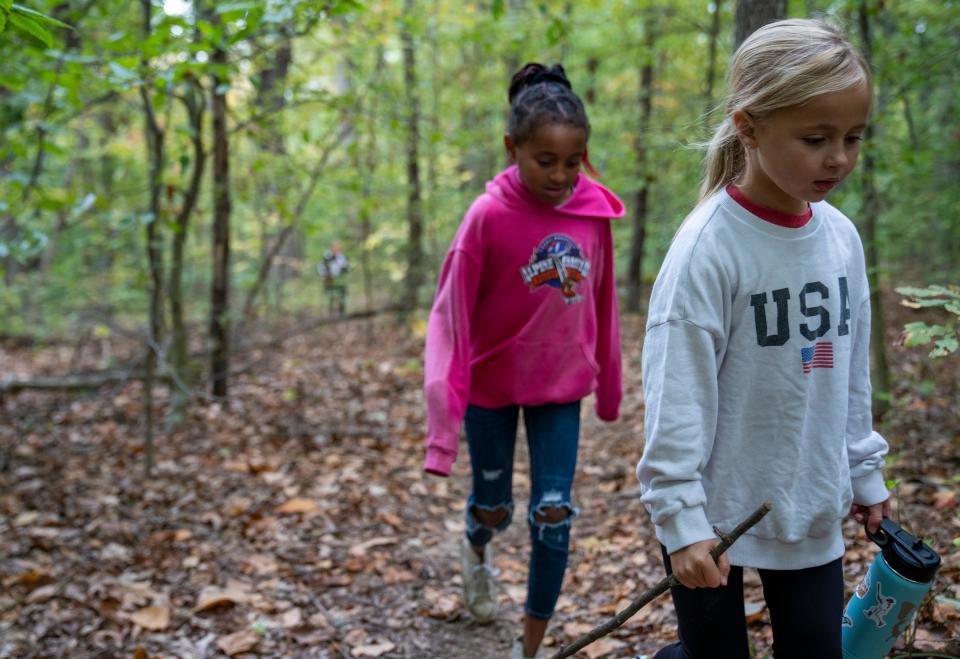Braun making another push to expand wilderness designation and uses in southern Indiana
A bill that would expand Indiana’s only federally protected wilderness and open some new recreational opportunities has been reintroduced by Sen. Mike Braun, R-IN, but this version of the proposed legislation makes concessions to some groups opposed to the original bill he filed last year.
The newly updated bill also has a Hoosier sponsor U.S. House of Representatives: Congresswoman Erin Houchin, R-9th District.
Braun said he approached Houchin last year about sponsoring the Benjamin Harrison National Recreation Area and Wilderness Establishment Act, but Houchin told IndyStar at the time that she was still reviewing the legislation.
Houchin has since decided to move forward and sponsor the revised bill in the House.
"The Hoosier National Forest is one of the most beautiful places in Indiana and surrounding areas,” Houchin said in a statement to IndyStar. “With this Act, we will increase recreation and tourism opportunities and preserve the land for generations to come."
But there are still concerns around the proposed legislation among some environmental and outdoor recreation advocates.
Recreation groups opposed to last year’s bill said more needed to be done to maintain user access and allow for public input. Others are concerned new designations made in the bill are not going through the typical vetting process.

What is the Benjamin Harrison National Recreation Area and Wilderness Establishment Act?
The Act would enlarge the Charles C. Deam Wilderness in Monroe and Brown counties to about 28,000 acres and designate another roughly 30,000 acres of adjacent land for a National Recreation Area.
The Deam wilderness currently spans 13,000 acres of hardwood forests legally preserved under 1964’s Wilderness Act, which requires land managers to maintain the area’s unimpaired natural condition.
Last year's bill: Proposal would double size of Charles C. Deam Wilderness area in Hoosier National Forest
New language in this year’s bills introduces “non-wilderness corridors” within Deam that would allow outdoor enthusiasts like mountain bikers a greater ability to maintain trails.
The bill also would establish the large recreation area, which allows for more intensive uses. The recreation area would border the proposed wilderness area to the south and east in Brown County.
“We tried to take everybody's input into consideration and end up with a product that was going to be pleasing,” Braun said. “It'll be the first big piece of legislation that acknowledges that recreation is a big part of how Hoosiers want to use their own resource, and this will make that possible to a greater extent.”
Jeff Stant, executive director of the Indiana Forest Alliance, said the bill is a once-in-a-lifetime opportunity.
“There’s no other area of wild forest in the lower midwestern U.S. of this size that can be protected as wilderness,” Stant said. “The key immediate result is going to stop burning and logging on the steep slopes at Houston South within a few miles of Lake Monroe.”
Houston South is a forestry management project proposed by the Hoosier National Forest to harvest 4,300 acres of pine and hardwood trees and perform prescribed fires on 13,500 acres.
Others are reading: Hoosier National Forest officials find no negative impacts with Houston South plan
Concerns remain on Wilderness bill
Paul Arlinghaus, former board member of the Hoosier Mountain Bike Association, said as the bill moves forward in Washington, he’s worried the non-wilderness corridors that allow robust maintenance access would be removed. He’s also concerned there was not enough public input baked into the process.
“There is a process for dedicating wilderness and that process is to go through the National Forest planning process to identify areas that could potentially be wilderness and all user groups would be brought to table,” Arlinghaus said. “All that has been sidestepped.”
Managing public lands is a complicated process, Arlinghaus said, and he doesn’t believe designating more wilderness is the correct way to protect the land.
“Wilderness is such a Draconian way to protect land,” he said. “There are other ways you can do it. We proposed the new wilderness to be part of the recreation area so it doesn’t put restrictions on recreation or tools.”
Stant said the primary purpose of the forest land is to protect Lake Monroe, which serves as a water supply, and provide for recreational use of the area while maintaining its aesthetic and scenic values, as well as the flora and fauna of the area.
The non-wilderness corridors have no chance of being removed from the bill as they are a top priority for the senator, Braun's office wrote in an email to IndyStar. The bill has gone through a two-year process, and the senator has taken feedback from both sides of the issue. The senator's team met with mountain biking groups, the email said, to discuss their ideas and concerns.
What’s next for the Wilderness bills?
With Braun running to become Indiana’s new governor next year, he said his goal is to get this across the finish line before he leaves the Senate. If not, he said it will hopefully be in a place where it would get picked up in his absence.
“I think for something narrow like this, once you’ve got the two most important components in place, then it’s a question of: how, on any bill, if you can’t get it to stand alone, how do you get it into something?” Braun said. “That doesn't mean there's not heavy lifting left, but we've got almost all the basics ready to go.”
Karl Schneider is an IndyStar environment reporter. You can reach him at karl.schneider@indystar.com. Follow him on Twitter @karlstartswithk
IndyStar's environmental reporting project is made possible through the generous support of the nonprofit Nina Mason Pulliam Charitable Trust.
This article originally appeared on Indianapolis Star: Houchin introduces House version of Braun's wilderness expansion bill
